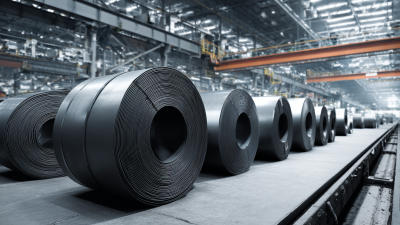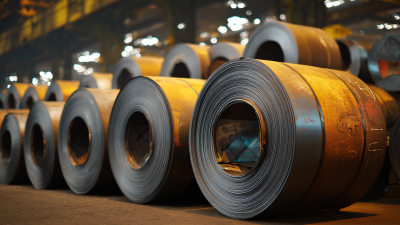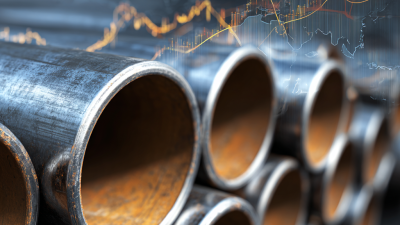In today's rapidly evolving manufacturing landscape, the significance of Carbon Steel Plate cannot be overstated. According to a report by Research and Markets, the global carbon steel market is projected to reach approximately $1 trillion by 2026, driven largely by its indispensable role in construction, automotive, and heavy machinery industries.

Carbon Steel Plate, known for its excellent strength-to-weight ratio and durability, serves as a fundamental material in the fabrication of critical components. A survey conducted by the American Institute of Steel Construction highlighted that nearly 75% of steel fabricators prioritize Carbon Steel Plate due to its versatility and cost-effectiveness compared to alternatives like aluminum or stainless steel. As manufacturers increasingly seek reliable and efficient materials to enhance productivity and sustainability, understanding the essential reasons behind the reliance on Carbon Steel Plate is crucial for staying competitive in the modern manufacturing arena.
Carbon steel plate has emerged as a versatile material essential for various manufacturing applications. Its adaptability allows it to be seamlessly integrated into fields like construction, automotive, and machinery production. According to industry reports, the global structural steel market is projected to reach USD 169.60 billion, driven by urbanization and sustainability initiatives. This growth underscores the increasing reliance on metal plates, particularly carbon steel, which offers robust strength and durability while being cost-effective.
Moreover, the advancements in manufacturing technologies, such as laser welding and cutting systems, further amplify the utility of carbon steel plate. The recent developments in automated manufacturing processes signal a shift towards precision and efficiency, making carbon steel an ideal choice for modern production demands. The utilization of carbon steel plates in these innovative applications proves essential in meeting the industry's evolving needs, particularly when coupled with cutting-edge tools that enhance productivity and material performance. This synergy not only elevates manufacturing standards but also aligns with the global trend towards more sustainable practices in the metalworking industry.
| Application Area | Key Benefits | Typical Thickness Range (mm) | Common Uses |
|---|---|---|---|
| Construction | High strength and durability | 5 - 50 | Structural beams, columns |
| Automotive | Cost-effective and lightweight | 2 - 20 | Chassis, body panels |
| Manufacturing | Versatile machining properties | 3 - 15 | Machinery parts, tools |
| Energy | Resistance to wear and tear | 10 - 40 | Oil and gas pipelines |
| Shipbuilding | Corrosion resistance with proper coatings | 5 - 100 | Hull fabrications, decks |
Carbon steel plate is a pivotal material in contemporary manufacturing, significantly enhancing strength and durability in various production processes. This type of steel offers an excellent balance of hardness and elasticity, making it ideal for high-stress applications. Its unique properties allow it to withstand significant loads and environmental challenges, ensuring that components made from carbon steel plate maintain their integrity under pressure. For industries such as construction and automotive manufacturing, the enhanced strength translates directly to improved performance and longevity of the final products.

Moreover, the durability of carbon steel plates contributes to reduced maintenance costs and longer lifecycle for machinery and structures. When utilized in manufacturing, these plates resist wear and tear, minimizing the need for frequent replacements and repairs. This longevity not only lowers operational expenses but also supports sustainability efforts by reducing material waste. As manufacturers strive for greater efficiency and reliability in their processes, carbon steel plates are becoming an indispensable element in achieving these goals. Their capacity to enhance both strength and durability positions them as a cornerstone of modern manufacturing techniques.
Carbon steel plate has emerged as a staple in modern manufacturing due to its remarkable cost-effectiveness. Unlike other materials, carbon steel offers an excellent strength-to-weight ratio, allowing manufacturers to create durable products without incurring excessively high costs. This is particularly beneficial for industries such as automotive, construction, and energy, where the efficiency of materials can significantly impact overall project budgets. The relatively low price of carbon steel plate compared to alternatives like stainless steel or aluminum makes it an attractive option for companies looking to optimize production costs while maintaining high standards of quality.
In addition to its affordability, carbon steel plate's versatility plays a pivotal role in its appeal to manufacturers. It can be easily cut, shaped, and welded, facilitating complex designs and rapid production cycles. This adaptability allows businesses to respond quickly to market demands and innovate without the risk of overspending on materials. The longevity and robustness of carbon steel plates also mean less frequent replacements, leading to further savings over time. As industries continue to seek ways to balance quality and cost, carbon steel plate remains an essential material driving modern manufacturing efficiency.
Innovations in carbon steel plate design have revolutionized the manufacturing landscape, offering unprecedented levels of efficiency and versatility. One of the key advancements is the development of high-strength, low-alloy (HSLA) steel plates, which provide superior strength-to-weight ratios. These advancements allow manufacturers to reduce material usage without sacrificing performance, leading to lighter structures that are easier to handle and transport. Additionally, improvements in surface treatments and coatings have enhanced corrosion resistance, extending the lifecycle of steel components and reducing maintenance costs.

Another significant innovation is the introduction of advanced manufacturing techniques, such as additive manufacturing and precision cutting technologies. These methods enable the production of complex geometries that were previously difficult to achieve with traditional machining processes. By utilizing carbon steel plates in more innovative ways, manufacturers can optimize their designs for performance and efficiency, ultimately enhancing their product offerings. The integration of digital technologies, such as computer-aided design (CAD) and computer numerical control (CNC) machining, further streamlines the production process, ensuring that manufacturers can meet tight deadlines while maintaining high standards of quality.
Carbon steel plates play a pivotal role in sustainable manufacturing practices, offering significant environmental benefits that align with the goals of modern industry. One of the primary advantages is their recyclability. Carbon steel can be recycled multiple times without losing its properties, which reduces the demand for raw materials and minimizes waste. This not only decreases the ecological footprint of manufacturing processes but also conserves energy compared to the extraction and processing of virgin materials.
Additionally, carbon steel plates contribute to energy efficiency in production. Their robust nature allows for thinner materials to be used without sacrificing strength, leading to lighter products that require less energy during transportation and assembly. Moreover, the durability of carbon steel ensures a longer lifespan for components, resulting in lower maintenance and replacement frequency. By incorporating carbon steel plates into their operations, manufacturers can significantly lower their carbon emissions, supporting a more sustainable approach to industrial production.









